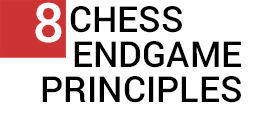The following chess endgame principles infographic, illustrates the 8 most important things you need to think about when playing an endgame.

Based on 12 Chess Endgame Principles
Category: Endgame
-

8 Chess Endgame Principles
-
The Philidor Position
The Lucena and Philidor positions are the most important positions to know when it comes to rook and pawn endings. Here we will be looking at the Philidor position, which allows Black to draw against an opponent that is up a pawn. It’s important to note that the Philidor position only works if the opponent’s pawn has not reached the 6th rank.
1…Rb6 This move keeps that White King off the 6th rank. [2.Rg7 Ra6 3.Rg6 Rxg6 Heading into a drawn King and pawn endgame. 4.Kxg6 Ke7 ] The Black rook heads to the first rank, to begin checking the White King. With the White pawn having been pushed, White does not have any cover from the upcoming Black rook checks.
2.e6
3.Kf6 Rf1+ 4.Ke5 Re1+ 5.Kd6 Rd1+ =
-
Five Preliminary Endgame Rules
1. Before even beginning to think of making a passed pawn, put all your pieces into as good positions as possible.
Queen – Center of board
Rooks – seventh rank for White, second rank for Black. But if the enemy has two or more minor pieces the rook must be careful about leaving his own camp and must be content with commanding the open file.
Knights – Square in the center or in the enemy camp, supported by a pawn which is cannot be attacked by a pawn.
Bishops – Center diagonals; pawn support is not essential but desirable.
King – Central, provided that he is not dangerously exposed. If the enemy has a rook, the King is best posted at or adjacent to e2(e7) or d2(d7) – fairly near the center, but still preventing the enemy rook from seizing the second (seventh) or first (eight) rank.
2. Avoid pawn-moves while you are getting your pieces well positioned because pawn-moves create lasting weaknesses and thus make your task harder.
3. Try to free your position from weaknesses; and if possible, make it hard for the opponent to do likewise.
4. When trying to win, keep pawns on both wings. When trying to draw, play to eliminate all the pawns on one wing. With pawns on one wing only, a pawn plus is usually insufficient for a win.
5. If you are a pawn up or more, exchange pieces (not pawns) wherever you can do so without losing in position.
Exception: do not rush an exchange that will leave you with a single bishop running on the opposite color to the enemy’s single bishop. Also, refrain from exchanging if it will give your opponent two bishops against bishop and knight.
CJS Purdy
-
Training Position #1
White wins this position by creating a passed pawn on the Kingside.
Note that if the Black pawn would be on d3 instead of c3, the game would be a theoretical draw.
Copy the FEN position 4k3/1pp2ppp/p1p5/8/4P3/8/PPP2PPP/4K3 w – – 0 0 and play this position against an engine.
NOTE: There was an issue with the original post. There was a missing White pawn on d4. The diagram and the FEN diagram have been updated.
-
Detailed Chess Training Schedule
Building upon the generic training schedule the detailed chess training schedule includes information on the topics and materials to be covered during my chess training sessions. This list is customized for me, but I am including it as an example for others to build upon as well as for my own reference.
Monday July 13th
Study Endings using Silman’s Endgame Course (1hr)
Solve tactics on chess.com (30min)Tuesday July 14th
Study Strategy from My System (1hr)
Solve endings using Chess Tempo (30min)Wednesday July 15th
Play G/30 Game
Annotate gameThursday July 16th
Solve strategy using content from Chess Master Schools (1hr)
Solve tactics on chess.com (30min)Friday July 17th
Study openings (Nimzo-Indian) (1hr)
Solve endings using Chess Tempo (30min)Saturday July 18th
Play G/30 Game
Annotate gameSunday July 19th
Catch-up day -
Endgame Positions
I have added a JavaScript replay chess board which contains critical endgame positions. Right now it contains three positions mainly King and pawn endgames dealing with the opposition, but I plan on adding more every couple of days.
-
Lucena Position
 Silman calls the Lucena Position “The Holy Grail of Rook Endings”. In this position Regardless of who’s turn it is to move, White wins.
Silman calls the Lucena Position “The Holy Grail of Rook Endings”. In this position Regardless of who’s turn it is to move, White wins.1.Rf2+ Forcing Black’s King to leave the scene of the battle.
1…Kg7 [1…Kg6 2.Rf4 Kg5 3.Rd4 Kf6 4.Ke8 Re1+ 5.Kf8 Rf1 6.d8Q+ Ke5+ 7.Ke7 ]
2.Rf4 Building a bridge.
2…Kg6 3.Ke7 Only now should White leave the cover of his pawn. Since promotion is threatened Black must go into checking mode.
3…Re1+ 4.Kd6 Rd1+ 5.Ke6 Re1+ 6.Kd5 Rd1+ 7.Rd4 Rxd4+ 8.Kxd4 Kf6 9.d8Q+ 1-0
-
King and Pawn Endings
The following game illustrates (starting in move 49.) how to exploit an extra pawn in a King and pawn endgame with many pawns left on the board. This example comes from James Howell’s excellent book ‘Essential Chess Endings’.
Things to remember:
1. Activate the king.
2. Create a passed pawn to tie down your opponent’s king.
3. Cut out any of your opponent’s counterplay.
4. Once your opponent has run out ouf pawn moves it should be easy to force his king back.
5. Either penetrate with your king and pick off your opponent’s pawns while they are busy dealing with your passed pawn or advance your king and passed pawn to paralyze your opponent’s king and force him to make concessions with his remaining pawns.
[Event “Germany”]
[Site “Germany”]
[Date “1992”]
[White “Glienke, Manfred”]
[Black “Jahn, Constanze”]
[Result “0-1”]
[ECO “A17”]
[Annotator “Howell, James”]
[PlyCount “134”]
[EventDate “1992.??.??”]
1. Nf3 Nf6 2. c4 e6 3. Nc3 Bb4 4. g3 b6 5. Bg2 Bb7 6. O-O O-O 7. d3 d5 8. cxd5
Nxd5 9. Bd2 Be7 10. Re1 c5 11. Nxd5 Bxd5 12. Bc3 Nd7 13. Qa4 Qc7 14. Rac1 Qb7
15. e4 Bc6 16. Qc2 Rac8 17. b3 Rfd8 18. Nd2 Bf6 19. Nc4 Bxc3 20. Qxc3 Nf6 21.
h3 Ne8 22. a4 f6 23. h4 Qd7 24. Bh3 Nc7 25. Re3 Qd4 26. Qe1 Rb8 27. Ra1 e5 28.
Ra2 Bd7 29. Bf1 Na6 30. Na3 Nb4 31. Nc2 Nxc2 32. Rxc2 Be6 33. Qc3 Qb4 34. Qxb4
cxb4 35. Rb2 Rbc8 36. Re1 Rc3 37. Reb1 a5 38. Be2 Rdc8 39. f3 Rc1+ 40. Bd1 R8c3
41. Kf2 Rxb1 42. Rxb1 Rxd3 43. Ke2 Rc3 44. Rb2 Kf7 45. Rc2 Bxb3 46. Rxc3 Bxd1+
47. Kxd1 bxc3 48. Kc2 Ke6 49. Kxc3 {Exploiting the extra pawn here is not
completely straightforward as White’s sole queenside pawn appears to be
holding up Black’s a-and b-pawns.} Kd6 50. Kc4 Kc6 {Both players now turn
their attention to the kingside, hoping to run the opponent out of pawn moves.}
51. h5 g6 52. h6 g5 53. g4 {White has the opposition and it looks as though
Black has lost the battle for tempi on the kingside. However, it turns out
that Black does not have to move her king.} b5+ {
It is now Black’s turn to move and he has lost the opposition.} 54. axb5+ Kb6
55. Kd5 Kxb5 56. Ke6 a4 57. Kxf6 a3 58. Kg7 a2 59. Kxh7 a1=Q 60. Kg6 Qa8 61.
Kxg5 Kc5 62. Kg6 Qf8 63. g5 Kd6 64. Kh5 Qxf3+ 65. Kg6 Qxe4+ 66. Kg7 Qb7+ 67.
Kg8 Qc8+ 0-1


